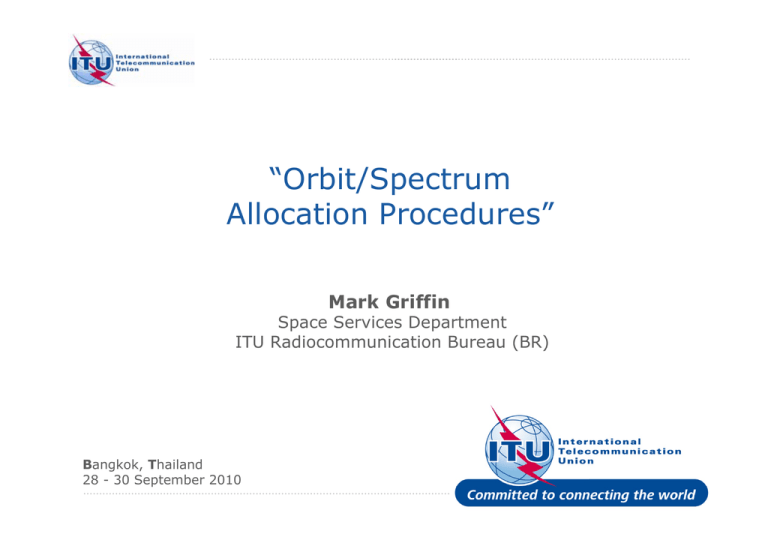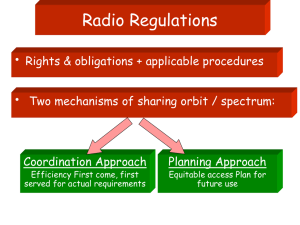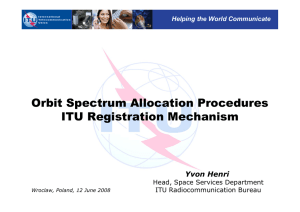“Orbit/Spectrum Allocation Procedures” Mark Griffin Space Services Department
advertisement

“Orbit/Spectrum Allocation Procedures” Mark Griffin Space Services Department ITU Radiocommunication Bureau (BR) Bangkok, Thailand 28 - 30 September 2010 International Telecommunication Union Committed to Connecting the World Legal Framework United Nations Outer Space Treaty (1967) Outer space free for exploitation and use by all states in conformity with international regulations States retain jurisdiction and control over objects they have launched into outer space Committed to Connecting the World Legal Framework United Nations Outer Space Treaty (1967) International Telecommunication Union Principles of use of orbit/spectrum Allocation of frequency bands Procedures, Plans, operational measures Instruments (CS, CV, RR, RoPs, Recs) Committed to Connecting the World ITU Constitution Article 44 Radio frequencies & satellite orbits are limited natural resources Rational, Efficient, Economical Use Equitable Access Committed to Connecting the World GSO SATELLITES INTERFERENCE Non-GSO SATELLITES TERRESTRIAL STATION TRANSMITTING EARTH STATION RECEIVING EARTH STATION Committed to Connecting the World Propagation of Radio waves • Laws of physics • Radio waves do not stop at national borders Interference • possible between radio stations of different countries • This risk is high in Space Radiocommunications Radio Regulations (RR) • One of its main purposes - Interference-free operation of Radiocommunications Committed to Connecting the World The Radio Regulations (international treaty) incorporates the decisions of the World Radiocommunication Conferences, including all Appendices, Resolutions, Recommendations and ITU-R Recommendations incorporated by reference. Frequency block allocations to defined radio services (Article 5) ¾ Mandatory or voluntary regulatory procedures (coordination, plan modification, notification, recording) that are adapted to the allocation structure ¾ Committed to Connecting the World Radio Regulations - Lengthy & complex +Efficient use of procedure spectrum +Equitable access Decided by Administrations +Opportunity to resolve during WRC before interference operation +Prevents loss of investment, customers & revenue by minimizing unusable capacity due to interference Committed to Connecting the World Radio Regulations Mechanisms Control of Interference ALLOCATION POWER LIMITS Frequency separation of stations of different services PFD to protect TERR services / EIRP to protect SPACE services / EPFD to protect GSO from Non-GSO REGULATORY PROTECTION e.g. No. 22.2: Non-GSO to protect GSO (FSS and BSS) COORDINATION between Administrations to ensure interference-free operations conditions Committed to Connecting the World Radio Regulations • Rights & obligations + applicable procedures • Two mechanisms of sharing orbit / spectrum: Coordination Approach Planning Approach Efficiency ⇔ First come, first served for actual requirements Equitable access ⇔ Plan for future use 10 Committed to Connecting the World Efficient & Rational Utilization “First Come, First Served” Procedure • Rights acquired through coordination with administrations concerning actual usage • Efficient spectrum / orbit management • Dense/irregular orbital distribution of space stations • Continuing responsibility for the networks 11 Committed to Connecting the World Efficient & Rational Utilization Article 9 (Sect.I, II) (Coordination procedure) App. 4 App. 5 Article 11 Exchange of information (Notification procedure) Article 21, 22 (Limits) Procedural Approach Objectives Res 49 Coordination … 12 Committed to Connecting the World Equitable Access Plan Procedure • Congestion of the GSO • Frequency / orbital position plans • Guarantee for equitable access to the spectrum / orbital resources – Spectrum set aside for future use by all countries – Predetermined orbital position & frequency spectrum 13


